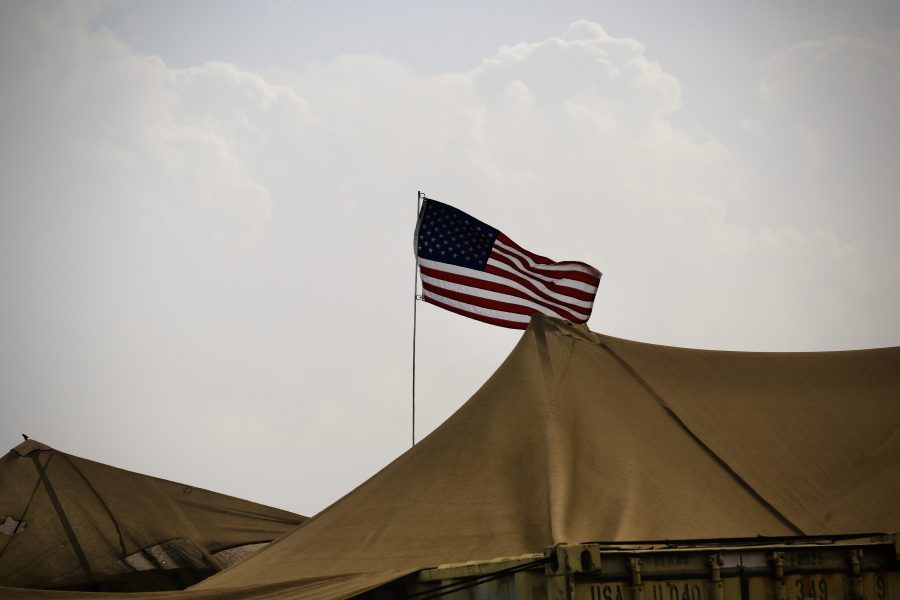The U.S. carried out airstrikes against two facilities in eastern Syria used by Iran’s Islamic Revolutionary Guard Corps and militias they support, the Pentagon announced Oct. 26.
Secretary of Defense Lloyd J. Austin III said the “narrowly tailored” strikes were intended to respond to a series of attacks against American forces in Iraq and Syria by Iranian-backed militias. The strikes were carried out by two U.S. Air Force F-16s, a senior military official told reporters.
“Iran wants to hide its hand and deny its role in these attacks against our forces,” Austin said in a statement. “We will not let them. If attacks by Iran’s proxies against U.S. forces continue, we will not hesitate to take further necessary measures to protect our people.”
Iranian-backed militias have carried out 19 attacks on U.S. military personnel in Iraq and Syria in the last 10 days, the Pentagon said Oct. 26.
Earlier in the day, the Pentagon said at least 12 of those attacks have taken place in Iraq while four have occurred in Syria. And the attacks, which U.S. officials say are encouraged by Iran, show no sign of ending, prompting White House warnings about a military response.
“My warning to the Ayatollah was that if they continue to move against those troops, we will respond,” President Joe Biden said at a news conference on Oct. 25, referring to Supreme Leader of Iran Ali Khamenei. “And he should be prepared.”
The attacks come amid a wave of unrest in the region spurred by Hamas’s Oct 7 attack on Israel and the Israeli air and ground response in Gaza.
To better protect U.S. forces, the Pentagon is sending a Terminal High Altitude Area Defense (THAAD) anti-missile battery to Saudi Arabia and Patriot surface-to-air missile systems to a number of Gulf states and Jordan, U.S. officials have said, manned by around 900 troops. Short range Avenger systems are also being deployed. So far, 21 U.S. troops in Iraq and Syria have sustained minor injuries in the attack but returned to duty. A U.S. contractor died when he suffered a cardiac event last week.
President Biden’s first use of force was in February 2021 when he ordered an airstrike against an Iranian-backed militia in Syria. That action came in response to a rocket attack against U.S. forces in Erbil, Iraq, earlier that month. In this and a subsequent military response in March 2023, the White House has stayed clear of striking targets in Iraq for fear of inflaming the political situation in the country where the U.S. still has 2,500 troops.
Some former military commanders say a forceful U.S. response is required and that militias in Iraq should not be off-limits if they mount drone and rocket attacks against U.S. forces.
“I don’t think we should take it,” retired Army Gen. Joseph L. Votel, who led U.S. Central Command (CENTCOM) from 2016-2019, told Air & Space Forces Magazine. “We have to be willing to back up our narrative.”
“Iraq is a unique location,” Votel added. “We are there at the invitation of the Iraqi government, and our actions there can have an impact on the internal politics and stability of the country. Nonetheless, that doesn’t mean our troops should have to absorb the risk of being attacked by Iranian-aligned militia groups in Iraq.”
In an Oct. 23 call, Austin urged Iraq’s prime minister to ensure that coalition troops, convoys, and diplomatic facilities are not attacked. But Iranian-backed militias are a potent force in Iraq and the Iraqi government has had difficulty reining them in.
A broader question is whether the U.S. should maintain a larger military footprint in the region to better deter Iran and its network of proxies.
“There’s this siren call that comes in the Middle East that always draws us back into it despite the fact that we are tired and we’re done with the wars in the Middle East,” Votel said. “The fact of the matter is we have enduring interests in the region and in order to protect those interests, we have to dedicate resources to them.”
